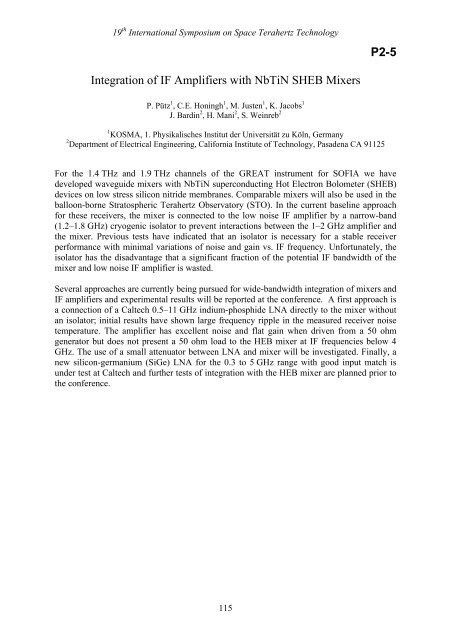Program and Abstract Book - SRON
Program and Abstract Book - SRON
Program and Abstract Book - SRON
You also want an ePaper? Increase the reach of your titles
YUMPU automatically turns print PDFs into web optimized ePapers that Google loves.
19 th International Symposium on Space Terahertz Technology<br />
P2-5<br />
Integration of IF Amplifiers with NbTiN SHEB Mixers<br />
P. Pütz 1 , C.E. Honingh 1 , M. Justen 1 , K. Jacobs 1<br />
J. Bardin 2 , H. Mani 2 , S. Weinreb 2<br />
1 KOSMA, 1. Physikalisches Institut der Universität zu Köln, Germany<br />
2 Department of Electrical Engineering, California Institute of Technology, Pasadena CA 91125<br />
For the 1.4 THz <strong>and</strong> 1.9 THz channels of the GREAT instrument for SOFIA we have<br />
developed waveguide mixers with NbTiN superconducting Hot Electron Bolometer (SHEB)<br />
devices on low stress silicon nitride membranes. Comparable mixers will also be used in the<br />
balloon-borne Stratospheric Terahertz Observatory (STO). In the current baseline approach<br />
for these receivers, the mixer is connected to the low noise IF amplifier by a narrow-b<strong>and</strong><br />
(1.2–1.8 GHz) cryogenic isolator to prevent interactions between the 1–2 GHz amplifier <strong>and</strong><br />
the mixer. Previous tests have indicated that an isolator is necessary for a stable receiver<br />
performance with minimal variations of noise <strong>and</strong> gain vs. IF frequency. Unfortunately, the<br />
isolator has the disadvantage that a significant fraction of the potential IF b<strong>and</strong>width of the<br />
mixer <strong>and</strong> low noise IF amplifier is wasted.<br />
Several approaches are currently being pursued for wide-b<strong>and</strong>width integration of mixers <strong>and</strong><br />
IF amplifiers <strong>and</strong> experimental results will be reported at the conference. A first approach is<br />
a connection of a Caltech 0.5–11 GHz indium-phosphide LNA directly to the mixer without<br />
an isolator; initial results have shown large frequency ripple in the measured receiver noise<br />
temperature. The amplifier has excellent noise <strong>and</strong> flat gain when driven from a 50 ohm<br />
generator but does not present a 50 ohm load to the HEB mixer at IF frequencies below 4<br />
GHz. The use of a small attenuator between LNA <strong>and</strong> mixer will be investigated. Finally, a<br />
new silicon-germanium (SiGe) LNA for the 0.3 to 5 GHz range with good input match is<br />
under test at Caltech <strong>and</strong> further tests of integration with the HEB mixer are planned prior to<br />
the conference.<br />
115
















